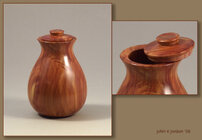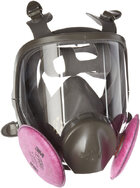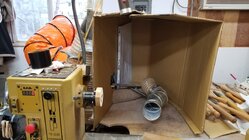Can I get quality results with the Minwax gloss spray can lacquer? I have heard about blemishes being a problem, is that a concern, and how could I address it? Honestly, I have only waited to try it because I am afraid of ruining a project, especially one that I can't simply strip because of the details on fragile pieces. Some people say it is easy, and others say it is a fine art to apply lacquer, so I am quite intimidated. For a can, what is your process, or what process would you recommend for someone who has never touched a can?
-
December 2025 Turning Challenge: Single Tree! (click here for details) -
Congratulations to Bob Henrickson, People's Choice in the November 2025 Turning Challenge (click here for details) -
Congratulations to Guillaume Fontaine for "Old Tea Pot" being selected as Turning of the Week for December 15, 2025 (click here for details) -
Welcome new registering member. Your username must be your real First and Last name (for example: John Doe). "Screen names" and "handles" are not allowed and your registration will be deleted if you don't use your real name. Also, do not use all caps nor all lower case.
You are using an out of date browser. It may not display this or other websites correctly.
You should upgrade or use an alternative browser.
You should upgrade or use an alternative browser.
Lacquer Help
- Thread starter Isaac Litster
- Start date
Practice first on a chunk of wood. Put it on a lazy Susan, spin slowly. Shake the can per instructions, Follow instructions on can. Also lots of YouTubes. Even this novice—me—can do it pretty well. You may want multiple coats, only need 10 minutes between coats. Others with more experience will soon opine.
Gloss is pretty shiny. May want semigloss . . .
Gloss is pretty shiny. May want semigloss . . .
Everything Alan said and keep your coats light. Just one pass.
I do a lot of hollow forms with small openings. I bent wire to fit the openings and I hang them from places in the shop and I wind them up so that they spin. As they spin I spray either a can of gloss spray can or gloss in a air brush. It takes just a short press of the can or brush to deliver a smooth light coating. And as lacquer is relatively fast drying I recoat every 30 minutes. Light coat is the secret as a little extra spray and you might find a run. I have found that doing it this way you do not make the area around you unbreathable where using a bigger spray gun (although it will do a good job) will really make the area smell for hours (the difference between a little spray - a can or brush and the big spray gun).
With lacquer remember the "Rule of 65". This isn't always possible for everyone depending on local conditions, but whenever possible spray when the temperature is above 65 and the humidity is below 65.
Can I get quality results with the Minwax gloss spray can lacquer?
I've used the Minwax laquer, except I almost never use gloss, prefer semigloss.
Don't work in an area with dust in the air.
Example shown below:
Started with wood smoothed by hand with very fine paper and 0000 Liberon steel wool.
Since the opening was relatively wide, before spraying the outside I covered it and lightly sprayed several coats inside.
I held the piece by hand upside down by a "mandrel" turned to lightly fit the opening and with a small dia "handle".
I think it's best to start the spray off to the side then move it over the piece.
Sprayed VERY light coats horizontally, very lightly, while turning by hand.
"Parked" the piece to dry on the mandrel in the bench vise. Drys quickly. Cleaned the nozzle after every coat.
After each coat was well dry, I smoothed the surface with the fine steel wool lightly before spraying the next.
I can't remember, applied maybe 8 coats, maybe 10. People often remark at how smooth it feels, inside and out.
Eastern Red Cedar

As for the button presses on the can, the motion of the passes, and the distance from the spray nozzle: unless you have already this a lot I recommend to practice, practice, practice first on something else, preferably the same wood, same smoothed surface, held in the air. It's easy to get runs or splatters if you spray too much, too close, and without a clean nozzle.
As for the "rule" of 65, my shop has heat and air. I am spoiled by the year-round comfort.
JKJ
Last edited:
Yes. The latest iteration of Minwax rattle can lacquer seems to have figured out the spray nozzle issues of other brands. It delivers a nice uniform spray with a good volume of lacquer and no flying boogers. With a little instruction and practice, lacquer is easy to apply.
Gloss does take some practice if you want a good finish without sanding/ buffing. Light coats that people are recommending doesnt always get you a good finish out the can. It needs to go on wet so it can flow. Of course too much and it will run.
It takes a little practice to get it right imo.
Satin or semigloss is much more forgiving. Gloss will show any issues.
It takes a little practice to get it right imo.
Satin or semigloss is much more forgiving. Gloss will show any issues.
If there is a piece that has tiny details, such as beads, rings, or grooves, does the lacquer pool in them? I have had CA finishes fill details, and the same with shellac, does the lacquer build up enough that the smallest details could be ruined?It needs to go on wet so it can flow. Of course too much and it will run
That's good to know, hopefully, my store has the latest iteration. The wood finishing section is at the end of the spray paint section, and some items such as shellac expired years ago. Thankfully the brand is not bad, maybe they can restock if I ask them.Yes. The latest iteration of Minwax rattle can lacquer seems to have figured out the spray nozzle issues of other brands. It delivers a nice uniform spray with a good volume of lacquer and no flying boogers. With a little instruction and practice, lacquer is easy to apply.
Unfortunately, I seem to have picked the worst place to live. It is 27F and 80% humidity. It's the dry season. Maybe somewhere in my house.I've used the Minwax laquer, except I almost never use gloss, prefer semigloss.
Don't work in an area with dust in the air.
Example shown below:
Started with wood smoothed by hand with very fine paper and 0000 Liberon steel wool.
Since the opening was relatively wide, before spraying the outside I covered it and lightly sprayed several coats inside.
I held the piece by hand upside down by a "mandrel" turned to lightly fit the opening and with a small dia "handle".
I think it's best to start the spray off to the side then move it over the piece.
Sprayed VERY light coats horizontally, very lightly, while turning by hand.
"Parked" the piece to dry on the mandrel in the bench vise. Drys quickly. Cleaned the nozzle after every coat.
After each coat was well dry, I smoothed the surface with the fine steel wool lightly before spraying the next.
I can't remember, applied maybe 8 coats, maybe 10. People often remark at how smooth it feels, inside and out.
Eastern Red Cedar
View attachment 72300
As for the button presses on the can, the motion of the passes, and the distance from the spray nozzle: unless you have already this a lot I recommend to practice, practice, practice first on something else, preferably the same wood, same smoothed surface, held in the air. It's easy to get runs or splatters if you spray too much, too close, and without a clean nozzle.
As for the "rule" of 65, my has heat and air. I am spoiled by the year-round comfort.
JKJ
Trying to figure out where in my house would cause the least problems, it's the only place where the temperature is above 40F, and the humidity is below 80 with no dust. Now that I think about it, I have two dogs, meaning I will have to think outside the box when I get to the real projects!With lacquer remember the "Rule of 65". This isn't always possible for everyone depending on local conditions, but whenever possible spray when the temperature is above 65 and the humidity is below 65.
If there is a piece that has tiny details, such as beads, rings, or grooves, does the lacquer pool in them?
I don't think so, as long as you spray it with very light coats and let each dry.
But I would do a test turning from the intended wood with some fine detail and try.
If spraying in the house, the fumes/odor can fill the space. Perhaps make a little spray booth from shower curtains or sheets of plastic.
Could possibly be hazardous if around something with a flame like the pilot on a gas appliance or spark from a faulty switch.
When I worked in the woodworking industry at Berea College in the late 60s I think the spray room had an exhaust fan to the outside.
JKJ
Rattle can lacquer is fairly thin and tends to go on in thin coats, but I would say yes it could. I would practice on scrap with some details cut to test first. You need to figure out how "wet" to spray it to get good results and you will only get that right with some practice.If there is a piece that has tiny details, such as beads, rings, or grooves, does the lacquer pool in them? I have had CA finishes fill details, and the same with shellac, does the lacquer build up enough that the smallest details could be ruined?
I think I am trying to do more than my resources permit. My parents won't be happy with a spray booth in the house; woodturning has taken over our shed, the cabin on our property, our yard, my room, shelves, and even a light box in the dining room! I'll see what is possible.I don't think so, as long as you spray it with very light coats and let each dry.
But I would do a test turning from the intended wood with some fine detail and try.
If spraying in the house, the fumes/odor can fill the space. Perhaps make a little spray booth from shower curtains or sheets of plastic.
Could possibly be hazardous if around something with a flame like the pilot on a gas appliance or spark from a faulty switch.
When I worked in the woodworking industry at Berea College in the late 60s I think the spray room had an exhaust fan to the outside.
JKJ
If it's nitrocellulose lacquer - everyone will know you are spraying it!! It creates lots of fumes. I use an exhaust fan too.I think I am trying to do more than my resources permit. My parents won't be happy with a spray booth in the house; woodturning has taken over our shed, the cabin on our property, our yard, my room, shelves, and even a light box in the dining room! I'll see what is possible.
I think I am trying to do more than my resources permit. My parents won't be happy with a spray booth in the house; woodturning has taken over our shed, the cabin on our property, our yard, my room, shelves, and even a light box in the dining room! I'll see what is possible.
The spray booth can be temporary, put up, use, take down.
Maybe do it at a friend's house. Sneak into their basement.
Rent a motel room in a run-down area of town.
Go visit a woodturning buddy who is generous with his space.
Or maybe try acrylic spray. I've use semi gloss with good effect. Takes longer to dry than lacquer. I don't know the temperature/humidity requirements. (Do a test)
Isaac, if the piece is important to you, it is not something to learn on. When you say blemishes, you probably mean blush. That is where moisture is added from the air as it is sprayed and becomes trapped in the finish before it can escape. That causes a foggy spot. In your environment, there are more practical finishes especially on one as you describe. As others suggested, learn on something else.
Spray a light mist of acetone from a clean gun on the blush. That usually brings the moisture to the surface and clears the finish. If the fog is too deep, there will be tiny pin holes where the water escapes to the surface.
I'll see what I can do with a can, I might get a gun if I fall in love. Thanks for the tip.Spray a light mist of acetone from a clean gun on the blush. That usually brings the moisture to the surface and clears the finish. If the fog is too deep, there will be tiny pin holes where the water escapes to the surface.
Isaac, just be aware, you do not want to breathe acetone, especially sprayed.
Check out https://turnawoodbowl.com/spray-lacquer-illustrated-guide-equipment-system-set-up-technique.
He uses a pneumatic sprayer, but the concepts are probably the same.
He uses a pneumatic sprayer, but the concepts are probably the same.
Trying to figure out where in my house would cause the least problems, it's the only place where the temperature is above 40F, and the humidity is below 80 with no dust. Now that I think about it, I have two dogs, meaning I will have to think outside the box when I get to the real projects!
Issac, using the "Rule of 65" does often mean that spraying indoors is the only way to find those conditions. I'm fortunate that I live alone and when I spray lacquer it is often indoors (with appropriate precautions) but I am not upsetting anyone.
I live in a high humidity area, and the moisture in the air is what can cause blushing. The "Rule of 65" greatly reduces the chances of blushing. I learned this from my good friend Kendall Westbrook who is a master of gloss finishes, and it works for me, although I usually work with satin finishes.
Isaac, just be aware, you do not want to breathe acetone, especially sprayed.
I use a full-face respirator like this when spraying chemicals, but with cartridge filters made for vapors rather than dust.

A quick google search indicates there is one for acetone.
However, I thought the the question about blemishes might not have been about blush but minor surface irregularities, far more noticeable with gloss than with matte, semi-gloss or satin. Multiple light misting coats of spray lacquer, each lightly smoothed with 0000 steel wool, shouldn't be susceptible to water-related blush like a heavier coat. But I'm not an expert. I'd read Flexner's book on finishing and see if he has advice.
I see he has a chapter on lacquer but don't know if it's appropriate here since I haven't had the need to read it yet.
However, I've found the book invaluable in the shop for other finishing info.
I see other finishing books but my shop library shelves are full... I'm stacking overflow on the floor now and I need to quit. Or have a book sale.
JKJ
Our club's most enthusiastic sprayer of lacquer sprays on his driveway as long as it's over 40 degrees with good results. We do have low humidity except 3 days in spring.

